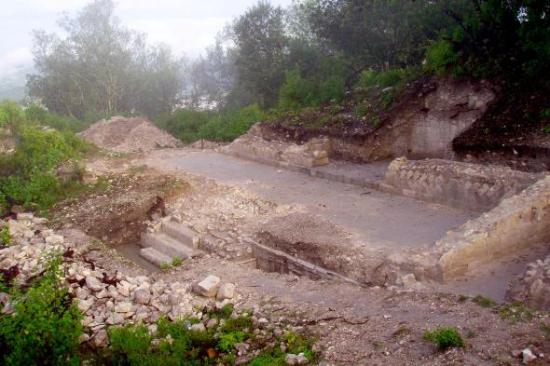Salmonella could be partially to blame for a 16th century epidemic that killed millions.
Sarah Gibbens
Source - https://news.nationalgeographic.com/2018/01/cocoliztli-salmonella-outbreak-mexico-dna-spd/
 A mass burial in the Teposcolula-Yucundaa Grand Plaza, shown prior to excavation. PHOTOGRAPH COURTESY OF CHRISTINA WARINNER, TEPOSCOLULA-YUCUNDAA ARCHAEOLOGICAL PROJECT
A mass burial in the Teposcolula-Yucundaa Grand Plaza, shown prior to excavation. PHOTOGRAPH COURTESY OF CHRISTINA WARINNER, TEPOSCOLULA-YUCUNDAA ARCHAEOLOGICAL PROJECT
From 1545 to 1550, Aztecs in what is today southern Mexico experienced a deadly outbreak. Anywhere from five to 15 million people died. Locally, it was known as cocoliztli, but the exact cause or causes has been a mystery for the past 500 years.
Now, a new study published in the journal Nature Ecology and Evolution suggests the outbreak could have been caused by a deadly form of salmonella.
Salmonella enterica—subset Paratyphi C to be exact—was present in the DNA of ten different individuals buried at the only known burial site, Teposcolula-Yucundaa, associated with cocoliztli.
According to study author Åshild Vågene from the Max Planck Institute, the strain is a bacterial infection that causes a type of enteric fever nearly identical to typhoid. While that specific strain of salmonella is much rarer today, Vågene says it would have spread similarly. Any food or water contaminated with the strain would have turned deadly once ingested.
Victims would have experienced a fever, vomiting, and likely a rash.
EXTRACTING ANCIENT DNA
Historians and archaeologists have long suspected that a blood-borne illness was responsible for cocoliztli. Depictions by both Spanish and indigenous artists show the infected with nose bleeds and coughing up blood.
Direct physical evidence, however, has been hard to find.
"This is one of the diseases that doesn't leave any visible clues on the skeleton," says Vågene, adding that very few diseases do.
So, to detect the presence of a pathogen, researchers instead turned to 500-year-old DNA embedded in the teeth of 24 indigenous individuals' remains.
Scientists ran the samples through a DNA sequencing analysis called MALT, a computational program that stores information from all known and characterized pathogens.
 Architectural investigations of the Grand Plaza resulted in the unexpected discovery of a large epidemic cemetery associated with the 1545-1550 cocoliztli epidemic. The cemetery was found to contain numerous mass burials, attesting to the catastrophic nature of the epidemic. PHOTOGRAPH COURTESY OF CHRISTINA WARINNER, TEPOSCOLULA-YUCUNDAA ARCHAEOLOGICAL PROJECT
Architectural investigations of the Grand Plaza resulted in the unexpected discovery of a large epidemic cemetery associated with the 1545-1550 cocoliztli epidemic. The cemetery was found to contain numerous mass burials, attesting to the catastrophic nature of the epidemic. PHOTOGRAPH COURTESY OF CHRISTINA WARINNER, TEPOSCOLULA-YUCUNDAA ARCHAEOLOGICAL PROJECT
"One of the most important aspects is we didn't need to make any assumptions," says Alexander Herbig, also from Max Planck and another author on the study. Instead of forming a hypothesis for several different pathogens, researchers could instead test the DNA against the huge swath in their database.
Of the 24 that were tested, 10 showed signs of salmonella. In addition to testing individuals that had contact with Europeans, the researchers also tested five individuals that had been buried before Europeans arrived. None of those five had DNA evidence of salmonella.
EUROPEANS TO BLAME?
When Europeans entered the Americas, historical records show they brought a number of infectious diseases with them, including smallpox and measles. These diseases disproportionately impacted native people—because they didn't have immunity to them.
Vågene and Herbig say their working hypothesis is that the same was true when the Spanish landed in Mexico.
In a study published in February of last year, researchers noted that this same strain of salmonella was detected in the DNA remains of a Norwegian woman who died in 1200. This means the specific strain that may have killed Aztecs in the 16th century had been present 300 years earlier across the Atlantic.
It's possible, says Vågene, that the pathogen had already been in Mexico. But such evidence has not been found.
ROOTS OF AN EPIDEMIC
To really confirm that salmonella contributed to the historical outbreak in Mexico, scientists would need to test more DNA from different sites.
"From a gut instinct I would suspect there were multiple agents involved in that epidemic," says Caitlin Pepperrell, a researcher who studies infectious diseases at the University of Wisconsin-Madison who was not involved with the study.
Pepperrell says a number of other factors could have been at work, many stemming from consequences of colonialism, including "disruptions in food supplies, famine, changes in the concentrations of populations, and relocation."
"It is hard to know for sure," says Anne Stone of Arizona State University's School of Evolution and Social Change, who was also not involved in the study. "But I think that it likely was of European origin because it was new to the population and it hit them so hard."
She says that more DNA samples from more burial sites could confirm this theory.
Vågene agrees that until archaeologists identify more cocoliztli sites, researchers can only hypothesize what caused the massive outbreak. In the meantime, Herbig adds, they'll continue using the DNA sequencing to find out what major diseases have impacted human history and how.